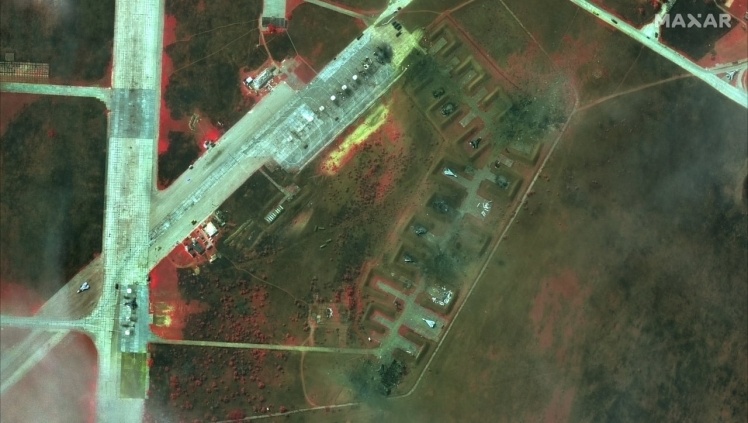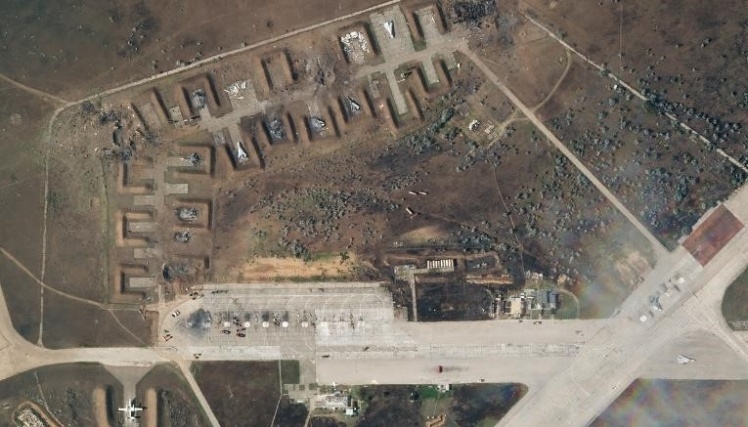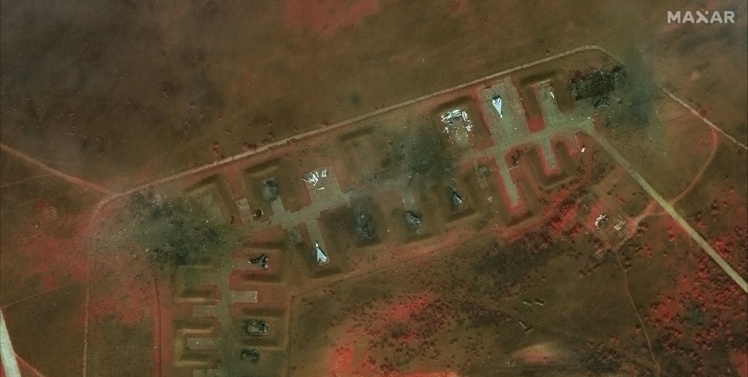At the beginning of July, Russian units reached the administrative borders of Luhansk oblast. After that, Putin ordered to give them a "rest". Since then, the so-called operational pause began, which was accompanied by a large-scale relocating of Russian troops to the south. In Donbas, the Russians now attack in only two directions — Bakhmut and the suburbs of Donetsk. Russia is moving most of its troops to the south of Ukraine — to Kherson and Zaporizhzhia oblasts.
Kharkiv oblast
The front line there has hardly changed since June. Then the Ukrainian Armed Forces launched a counteroffensive and were able to repel the Russians from the outskirts of Kharkiv. To the north of the city, the occupiers left mainly poorly prepared units of mobilized residents of the occupied Donbas — and this allowed the Ukrainian military to quickly return control of the outskirts of Kharkiv. In one of the areas, the Ukrainian army was able to reach the state border, but the Russians pulled up reserves and stopped the counteroffensive.
The main goal of this counteroffensive was to deprive the Russians of the opportunity to reach Kharkiv with artillery. However, the shelling of the city doesnʼt stop, as the Russian army has long-range MLRS and missiles. In addition, Kharkiv is located only 30 kilometers from the border, which allows the Russians to fire from their territory. Also, the occupiers sometimes try to carry out tactical offensives in the direction of Dementiivka, Ud, and Verkhnyi Saltiv, but they fail every time.
Recently, the Russians have also become more active in the area of occupied Balaklia. They have already tried several times to advance in the direction of Husarivka and Velika Komyshuvakha (unsuccessfully). In the section of the front between these villages, the Siverskyi Donets river, which has a strong bend in the direction of Izyum, actually serves as the demarcation line. The distance from this occupied city to the nearest positions of the Ukrainian Armed Forces is 15 kilometers. This may allow Ukrainian troops to cross the river and reach the outskirts of Izyum. Thatʼs why the Russians probably want to capture the right bank of the Siverskyi Dinets in order to have a buffer zone around the city.
On the border of the Kharkiv and Donetsk oblasts, the Russian army significantly reduced the number of its troops. Apparently, the occupiers have given up their plans to advance on Slovyansk. Most of the Russian units from Izyum and Lyman went to the south of Ukraine. This allowed the Armed Forces of Ukraine to conduct a local counteroffensive and liberate the villages of Dmytrivka and Dibrivne in Kharkiv oblast and Mazanivka in Donetsk oblast. Also, the UAF pushed the Russians to the outskirts of Bohorodychne. A video appeared on social networks showing how a Ukrainian flag was hung on the monument to Artyom near the Sviatohirska Lavra. The Lavra itself is located on the opposite to Sviatohirsk bank of Siverskyi Dinets. The fact that Ukrainian troops are moving unhindered near the Lavra indicates that Russian forces have significantly decreased in numbers in Sviatohirsk itself.
Donetsk oblast
In addition to the actual rejection from the offensive on Slovyansk, a similar situation arose with the offensive on Siversk. Here, the Russians have been unable to move forward for a month, since they entered the administrative border of Luhansk oblast. The Ukrainian Armed Forces repel Russian tactical offensives in the direction of Verkhnyokamyanske, Serebryanka, and Ivano-Daryivka. The distance from Siversk to the nearest positions of the Russian army is about 10 kilometers, this allows the occupiers to shell the city.
Fierce fighting is currently going on around Bakhmut. Here, the units of Wagner private military company take part in the offensive, their goal is to break through to the outskirts of the city from several sides at once. Currently, fighting is also taking place on the outskirts of Soledar. If the occupiers capture it, they will be able to cut the road between Bakhmut and Siversk and take under fire control the M-03 route, which connects Bakhmut and Slovyansk. The Russians are trying to break through to the southern outskirts of Bakhmut in order to also reach the Bakhmut-Kostyantynivka road. Therefore, the Russian troops do not want to engage in street fighting yet, but seek first to surround the city and cut it off from supplies.
Another place of fierce fighting is the suburbs of Donetsk, from Avdiyivka to Maryinka. In 8 years, this line turned into a powerful fortified area, which the Russians are now trying to break with the massive use of artillery and infantry. In fact, almost all the troops of the "L/DPR" were concentrated on the 30-kilometer section with the support of Russian artillerymen and aviation. They were able to advance and capture some of the forward positions of the Ukrainian Armed Forces, but the pace of the offensive now begins to slow down. The most difficult situation is in Pisky, where the Russians were able to capture part of the village, and completely destroy the rest, in particular with the help of heavy flame-throwing systems Solntsepyok. Taking Pisky will open the way for the occupiers to surround Avdiyivka from the south and north: they also hope to surround the city. Fighting also continues on the outskirts of Krasnohorivka and in Maryinka. The main goal is to force the Ukrainian Armed Forces to retreat from the suburbs of Donetsk and make it impossible to attack bases and warehouses in the city itself and beyond.
At the end of June, the Armed Forces of Ukraine carried out a minor tactical offensive south of Vuhledar. After that, the Russian troops repeatedly tried to restore lost positions and return to the outskirts of the city, but they did not succeed.
«Babel'»
«Babel'»
Zaporizhzhia and Kherson oblasts
It is here that Russia transfers most of its troops, concentrating almost half of all its occupying forces. A significant part of them was transported to the right bank of the Dnipro river — to Kherson. Thus, the Russians can prepare for defense during the announced counteroffensive of the Ukrainian Armed Forces. On the same bank of the Dnipro, a large part of the Russian amphibious units, which are intended primarily for offensive, not for defense, were deployed. Therefore, the occupiers may try to advance towards Mykolaiv and Kryvyi Rih. On the left bank of the Dnipro, Russian troops are also strengthening, and they may launch an offensive on Zaporizhzhia.
Meanwhile, the Ukrainian army, with the help of long-range weapons, is trying to disrupt the logistics of the Russians. All their grouping on the right bank of Dnipro is connected with the rest of the occupied territory with just three bridges: Antonivsky automobile bridge, Antonivskyi railway bridge, and the dam of the Kakhovka HPP. All three are regularly hit by the UAF, and the occupiers have already closed the Antonivsky automobile bridge to traffic and are using the ferry crossing.
«Babel'»
«Babel'»
Also, the Ukrainian Armed Forces actively destroy ammunition depots, radars, and enemy air defense systems. HARM anti-radar missiles help in this. After the Russians published a photo of the wreckage of such a missile that hit their positions, the Pentagon officially confirmed the deliveries. The HARM missile has a range of approximately 150 kilometers. It detects the radiation of radars and anti-aircraft systems and targets them. This forces the Russians to constantly move their air defense systems and occasionally turn off their radars. In addition, it is not clear how exactly such missiles are launched, since in the USA they are attached to Western aircraft, which Ukraine does not have. There are two versions: either these missiles were modified to be installed on Soviet-era aircraft, or special ground-based launchers were developed and transferred to Ukraine.
The most important event was the explosions at the Saky airfield near Novofedorivka in the Crimea. Satellite images show at least 8-10 destroyed aircraft of the Russian army. This airfield was used by the Russian aviation to attack Ukrainian positions in the south. It is more than 200 kilometers from the airfield to the nearest positions of the Ukrainian Armed Forces, and Ukraine officially does not have such long-range weapons. Publicly, the Ukrainian army does not take responsibility for the explosions, but three Western media, citing sources in the Ministry of Defense of Ukraine, confirm that the UAF are behind the attack. The Washington Post writes that it was an operation by special squad. There are also versions that Ukraine either modified its own or received Western (for example, ATACMS) missiles with increased range.
Satellite images of Saksky airfield in Crimea after the explosions
Experts believe that the strike on the airfield in Crimea will lead to an escalation on the front, but it is not clear how exactly this will happen. Since February 24, Russia has been using absolutely all available conventional weapons in Ukraine, and half a year after the start of the invasion, under the conditions of sanctions, it cannot dramatically increase its offensive potential in terms of quantity and quality. Only chemical, biological and nuclear weapons remain unused, and covert mobilization, according to Western intelligence, is slow.
The situation around the Zaporizhzhia NPP — the largest nuclear power plant in Europe — has also worsened. The Russian army seized the ZNPP and Energodar at the beginning of the invasion and turned the plant into a military base. At the same time, the opposite bank of the Dnipro river, where Nikopol and Marganets are located, is controlled by Ukraine. The distance from them to the ZNPP is less than 20 kilometers, but only recently the Russians began actively shelling these cities from the territory of the station, trying to provoke fire at the ZNPP in response. The Ukrainian army has several times struck Russian positions at the NPP and Energodar, but with the help of drones to make the strikes more accurate and less destructive. Now, Russia has begun shelling the territory of the ZNPP with multiple rocket launchers. On the one hand, she blames Ukraine, and on the other hand, blackmails the West with a nuclear accident. Perhaps the Russians will try to negotiate the creation of a demilitarized zone around the ZNPP in exchange for certain concessions, in particular regarding sanctions. And if it fails, they will disconnect the station from the energy system of Ukraine and transfer supplies to Crimea. The head of the Ukrainian state nuclear plants operator Energoatom Petro Kotin has already suggested that if the operation of the ZNPP is switched to the Crimean peninsula, the Ukrainian military can break the power lines.
Translated from English by Anton Semyzhenko.
We monitor the situation at the front every day. You can support Babel anytime and right now too: Patreon 🔸 [email protected]🔸donate in cryptocurrency🔸in hryvnia.
Russian troops enter the territory of the Zaporizhzhia NPP, May 1, 2022.






